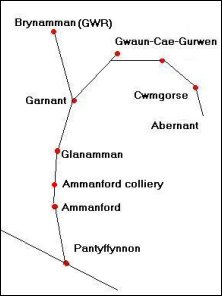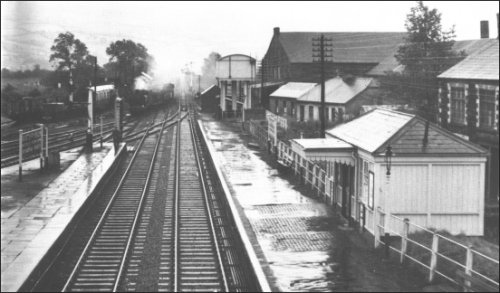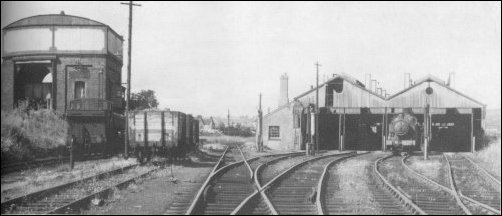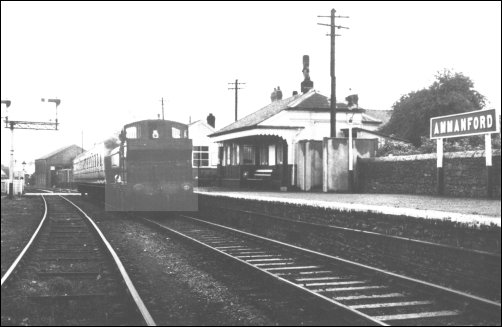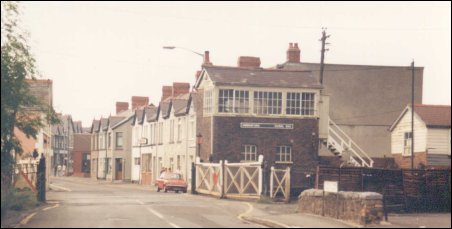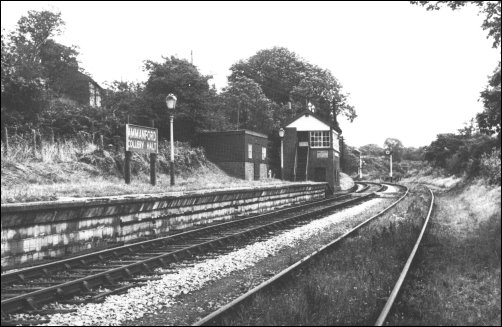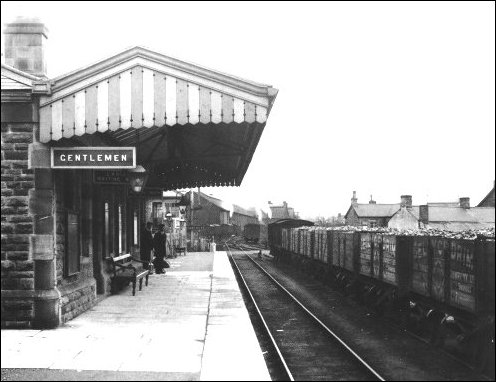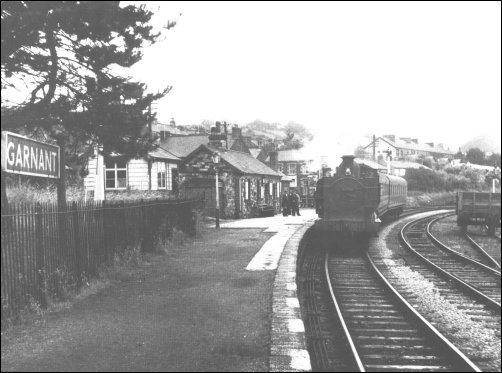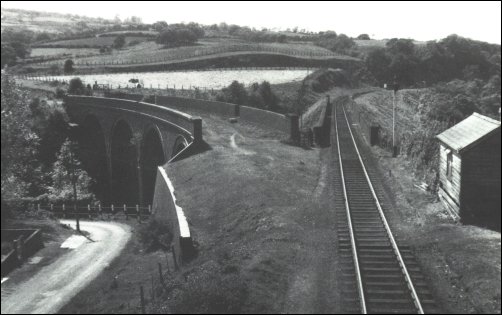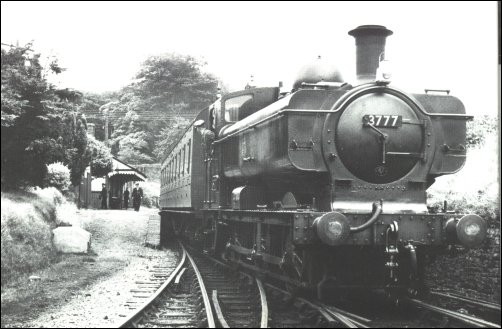RAILWAY STATIONS
The Amman Valley Branch Line
(Pantyffynnon, Ammanford, Ammanford Colliery Halt,
Glanamman, Garnant, Gwaun Cae Gurwen, Brynamman)
The Llanelly Railway and Dock Company, founded in 1835, had reached Pontardulais by 1839 and arrived at Pantyffynnon in 1840. Here the railway system branched, with one arm stretching up the coal bearing Amman Valley and reaching Garnant by 1841 before terminating at Brynamman in 1842. In 1864 another railway company - the Swansea Vale Company - reached Brynamman along the Swansea Valley from Swansea, St Thomas station, through Morriston, Pontardawe and Ystalfera. Brynamman thus had two railway stations across the road from each other and to continue your journey from there to any of the Swansea Valley stations you had to change stations as well as trains!
On nationalisation of the railways in 1948, the station on the Amman Valley line was called Brynamman West by the newly created British Railways and the Swansea Valley station was called Brynamman East. In 1950 British Railways abruptly closed the Swansea Valley line from 25th September 1950 and the Pantyffynnon to Brynamman line was closed in 1958.
Initially the railways of Britain were created to convey freight, especially coal and steel which were products crucial to the industrialization of the country. The Amman Valley is a part of the anthracite district on the western edge of the South Wales coalfield and its coal seams were - and still are - rich indeed.
Coal was worked in a minor way before 1700 by local farmers, probably by surface scouring of the various outcrops but the first known deep mine was opened at Brynlloi, Glanamman in 1757 although its output was limited and was used principally for domestic consumption within the valley itself. But after the Llanelly railway and Dock Company reached Brynamman there was an explosive growth in coal mining. By 1914 there were about 100 privately owned coal mines in the Amman valley and the peak of production was around 1920.
The manpower in the anthracite industry in the Amman Valley from 1911 was -
1911 8,060 1921 9,300 1931 8,540 1941 4,580 Soon after the First World war ended in 1918 there was a steady decline with two periods in particular seeing large scale pit closures. The first was after 1926 and the defeat of the General Strike that year. Miners were locked out for seven months before being forced back to work under humiliating terms. The next wave of pit closures was, ironically, after the industry was nationalised by a newly returned Labour Government at the end of World War two. In 1947 the National Coal Board (NCB) was created but the jubilation felt by the mining communities across the country, who thought that they now owned and controlled their industry, was short lived. Most of the Amman valley pits were closed throughout the 1950's and 1960's.
The scale - and speed - of the pit closure programme after nationalisation in 1947 can be seen from the following table.
Colliery Date of Closure Approximate manpower before closure Maerdy, Tairgwaith Glanamman Saron Brynhenllys Gelli Ceidrim Llandybie Blaenhirwaun * Cwmllynfell Steer Pit, Tairgwaith Mount (Butchers) Great Mountain * East Pit, Tairgwaith Cross Hands * Cwmgors Wernos Pantyffynnon Total manpower [Collieries marked * are strictly speaking outside the Ammanford and Amman valley area but provided employment for a considerable number of men in the area]
Tinplate was also an important part of the economy in the area; at one point there were five tinplate factories in Ammanford and the Amman valley: at Brynamman, Garnant, Glanamman, Pantyffynnon and Tirydail and there had also been one at Aberlash. But by 1945 all had closed and coal and some manufacturing remained the key industries until the post war pit closure programmes took their toll.
But we digress - let's take that journey up the Amman Valley along the old branch line. First, Pantyffynnon which was the junction where the two railway lines diverged.
Pantyffynnon Station
Pantyffynnon was the junction for the Brynamman branch and was served by trains to Swansea, Shrewsbury and Llanelly. As well as local goods traffic, a considerable tonnage of coal was raised from local pits in the area, all providing work for the engineers in the small sheds in Pantyffynnon (see photo below). From the station footbridge, looking south towards Pontardulais, locomotive No 3719 is seen arriving with an engineer's train and swinging off the main line to the sidings alongside the branch. The branch line itself is the single track curving left off the main track. The large building at the top right is the former Dynevor Tinplate Works. The summer weather appears not to have been any better in those days. (Photo taken 29th July 1958.)
Pantyffynnon Railway Shed
Pantyffynnon shed was relatively modern - it was opened in 1931 to replace the Llanelly Railways depot at Garnant and had its own allocation of about 15 engines. Closure took place in 1964 and the sheds were demolished in 1968. (Photo taken 15th May 1960.)
Ammanford
Next stop after Pantyffynnon junction was Ammanford at the end of Quay Street. Here the 11:38 to Brynamman arrives hauled by locomotive 3777 (the loco is hitched to the coach back to front). For many years after closure in August 1958 the only evidence of this station were the automatic level crossing barriers and the signal box (below). In a typical act of vandalism the signal box was demolished by British Railways in 1987. (Photo taken 29th July 1958.)
Ammanford Colliery Halt
A 'Halt' was a request station where trains stopped only if passengers were getting on or off. Ammanford Colliery Halt was just off High Street and served people in the Pontamman and High street area. Trains called at the Halt during daytime hours only and passengers had to obtain their tickets from the signal man. (Photo taken 29th July 1958.)
Glanamman
Members of the station staff watch the photographer at work in this pre-1914 view of Glanamman Station. The station served an area characterised by anthracite mines and tinplate works. There is plentiful evidence of both industries in the picture; on the right is a rake of loaded wagons from the nearby Gelliceidrim colliery whilst the Raven tinplate works, behind the three plumes of steam, is visible in the background, beyond the level crossing.
Garnant
The line to Brynamman left the Gwaun Cae Gurwen branch at Garnant and the station there was situated at the station fork. At the platform is locomotive No 8708 with the 3:40 to Brynamman. (Photo taken 29th July 1958.)
Gwaun Cae Gurwen
At Gwaun Cae Gurwen the junction was to have been triangular, with an east curve from the existing line to join the new line. A four-arch viaduct bridge was built, but it was never used.
Brynamman
Having run round its carriages and backed into the station, No 3777 stands ready to depart so the driver leans out of the cab to see what is happening on the platform. The locomotive appears to have been recently cleaned, perhaps in expectation of the imminent closure of the line. This passenger service was withdrawn and the section from here to Garnant was closed completely from 18th August 1958. The track for the Brynamman to Garnant section has long been pulled up and nature has reclaimed the land where the track once was. (Photo taken 29th July 1958.)
There is a web site for the Amman Valley Railway Society, with more history and photographs, which can be found on: http://ammanvalleyrail.netfirms.com
